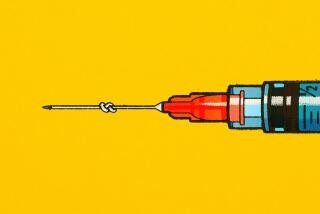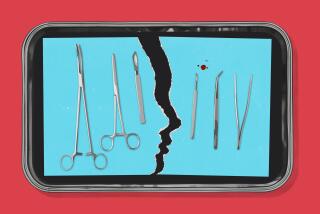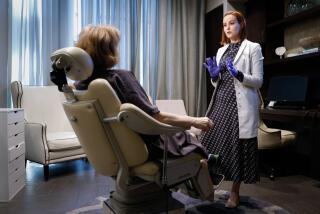The Age of Discontent : Boomers Turn to Cosmetic Surgery as Prices Decline
- Share via
The first wave of the massive baby boom generation has turned 50. And many boomers apparently don’t like what they see in the mirror.
Cosmetic surgeries that make people look younger or thinner are enjoying a surge in popularity, in part because of vanity but also because the procedures have become more affordable. Roughly 400,000 Americans underwent face-lifts, collagen treatments, chemical peels, eyelid lifts and other procedures in 1994, the most recent period for which statistics are available.
To be sure, the popularity of some procedures--such as breast enhancements and nose reshapings--has fallen or remained relatively stable. But those that address the extra pounds and additional wrinkles that appear with age are coming on strong.
Liposuction, introduced just over a decade ago, is now the nation’s most popular cosmetic surgery, with more than 51,000 Americans opting to have their fat cells sucked away in 1994 compared with 47,212 in 1992. Chemical peels--a wrinkle-erasing technique introduced only a few years ago--found 29,072 takers in 1994, up 53% from 1992. Although breast augmentations are down from their heyday, breast “lifts” are up a tidy 26% over the last two years, according to the American Society of Plastic and Reconstructive Surgeons in Arlington Heights, Ill.
“Liposuction has been wildly popular since its introduction,” says Dr. Gerald H. Pitman, attending plastic surgeon at Manhattan Eye, Ear and Throat Hospital in New York. “It’s a procedure that really addresses society’s desire for youth and good health--or at least the appearance of youth and good health.”
The average cost of many popular procedures has plunged, particularly in major cities where demand is high and plastic surgeons are plentiful.
For what it cost to have a pound of closely congregated fat cells sucked away in 1986, you can have 20 pounds of fat removed from all over your body in 1996, says Dr. Richard Greco, a plastic surgeon from Savannah, Ga. The average price of liposuction was $4,000 per site in 1986, but it’s $1,639 today, according to the plastic surgeons trade group.
The cost of an osteotomy, which involves cutting and moving a portion of your chin bone to improve your profile, is 18.4% cheaper in California than it was two years ago. The fees for a full-face, wrinkle-removing chemical peel have dropped between 10% and 20% over the last two years in four major cities surveyed by the plastic surgeons trade group. Nationwide, the average cost has fallen 8.9% over the last two years, to $1,488.
The end result is that cosmetic surgery has gone from being a luxury only for the affluent to being something much of the middle class can afford, surgeons say.
“People think that cosmetic surgeries are $20,000 or $30,000,” says Dr. Robert Kotler, a Beverly Hills plastic surgeon. “They’re not. A lot of these procedures are very popularly priced.”
However, plastic surgeons caution, costs have come down in part because a greater number of less experienced doctors are in the market. Indeed, a host of doctors ranging from dermatologists to general practitioners have taken up cosmetic surgery as a sideline, industry experts say. There’s nothing that legally bars any medical doctor from performing cosmetic surgery. However, the economics of cosmetic surgery have recently become so attractive that more doctors are eager to add it to their practices.
The reason: In most cases, customers pay the costs out of their own pockets. That means no health maintenance organizations. No insurers. No government Medicaid auditors saying which procedures will and won’t be reimbursed. And usually, the customers pay in advance. That makes it an attractive business for doctors who don’t like the paperwork or second-guessing and cost controlling that goes on when dealing with companies that control medical-care purse strings.
But it also means it is imperative that consumers be careful as well as cost-conscious. Remember, there is a risk involved with any surgery. An artless--not to mention bungled--face-lift can be worse than no face-lift at all.
So how do you find a cosmetic surgeon who is both skilled and reasonably priced?
Do your homework. Get referrals from your doctor, trade groups, hospitals and public health offices. Don’t be in a hurry. Ask as many experts as possible about doctors they’d recommend for the surgery you are considering. Chances are, a few names will be mentioned numerous times. Narrow your search to the few that appear highly recommended by the widest group.
Then spend an afternoon investigating the costs and consequences of the operations you’re interested in. Simply call the offices of the physicians you’re considering and ask for a range of prices and details about the surgery you think you want.
Make apples-to-apples comparisons when price checking. Some surgeons may tell you their fees, but not mention that the actual price will be twice as much once you factor in the services of an anesthesiologist, attending nurse, medical tests and, possibly, hospital fees. Other physicians will estimate the cost for the entire procedure. The point is: Be sure to ask what’s included and whether the quoted charges will cover everything you’ll need.
Finally, when you’ve narrowed down your list to two or three surgeons, call and set up a consultation. Realize that many doctors will charge you a consultation fee ranging from $50 to $150. But that fee will usually be deducted from your surgery bill if you choose that particular doctor.
These in-person meetings are necessary, for two reasons. First, surgeons can’t quote a cost until they’ve evaluated the job. Second, in some cases patients think they need one type of surgery when they’d be better off with another. Some of Kotler’s patients come in asking for face-lifts, for example, when they might be better off with a less expensive chemical peel.
In addition to discussing the procedure, services, costs and payment options, be sure to ask for patient referrals, Greco says.
Most cosmetic surgeons have portfolios of before-and-after photographs and will provide names and numbers of satisfied customers.
(BEGIN TEXT OF INFOBOX / INFOGRAPHIC)
Making the Cuts
Liposuction is now the nation’s most popular plastic surgery. Most common cosmetic procedures in 1994:
*--*
Procedure No. performed 1. Liposuction 51,072 2. Eyelid surgery 50,838 3. Breast augmentation 39,247 4. Nose reshaping 35,927 5. Face lift 32,283 6. Chemical peel 29,072 7. Breast implant removal 28,655 8. Collagen injections 27,052 9. Retin-A treatment 20,875 10. Tummy tuck 16,829
*--*
The average cost of many popular procedures has plunged, particularly in major cities where demand is high and plastic surgeons are plentiful. Average cost of common procedures, by region:
*--*
Procedure California New York Florida Texas breast reduction $4,920 $5,514 $5,105 $4,583 Face lift 4,395 5,979 4,194 4,448 Tummy tuck 3,984 4,881 3,921 3,700 Nose reshaping 3,016 4,253 2,774 2,976 Breast augmentation 3,060 3,283 2,628 2,745 Eyelid surgery 2,870 3,508 2,679 2,666 Liposuction 1,888 1,774 1,750 1,482 Chemical peel 1,660 1,777 1,482 1,314 Collagen injection 293 295 257 265 Retin-A treatment 74 131 53 74
*--*
More to Read
Sign up for Essential California
The most important California stories and recommendations in your inbox every morning.
You may occasionally receive promotional content from the Los Angeles Times.













